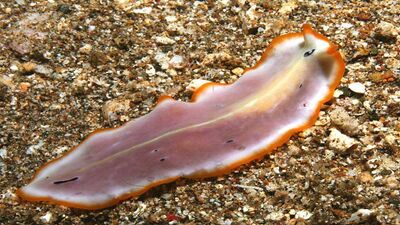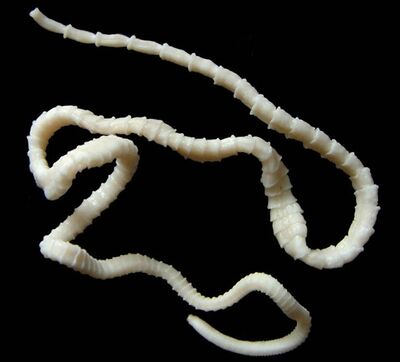Flatworms

| |
| Kingdom: | Animalia |
|---|---|
| Subkingdom: | Eumetazoa |
| Clade: | ParaHoxozoa |
| Clade: | Bilateria |
| Clade: | Nephrozoa |
| Unranked: | Protostomia |
| Unranked: | Spiralia |
| Clade: | Rouphozoa |
| Phylum: | Platyhelminthes |
| Source: Integrated Taxonomic Information System | |
Flatworms are the simplest of the worm groups. There are roughly 20,000 species. Flatworms are found globally and can be free-living or parasitic. One of the best-known flatworms is the tapeworm.

Habitat
Flatworms can be found in a wide range of habitats, including freshwater, marine environments, and damp soil. Some species are also parasitic and can live inside the bodies of other animals.
Diet
Flatworms have a diverse diet that varies depending on the species. Many flatworms are carnivorous and feed on small animals (example: crustaceans, corals, and other invertebrates) while some are scavengers and feed on dead or decaying organic matter. There are also parasitic flatworms that feed on the tissues and fluids of their host organisms.
Reproduction
Flatworms species are hermaphroditic, meaning that they have both male and female reproductive organs. Some species can also reproduce asexually by splitting themselves into two or more pieces that can then regenerate into complete individuals.
Anthropogenic Benefits
Some flatworms are important predators, helping to control populations of small animals and maintaining the balance of their ecosystems. Additionally, flatworms can help to break down dead organic matter, which contributes to nutrient cycling in ecosystems. Some species of flatworms also have medical applications, as they produce compounds that have potential for use in medecine.
Anthropogenic Drawbacks
Flatworms can be harmful to humans and animals as parasites, causing diseases or negatively affecting their hosts' health.
| Attribute | Cnidarians and Ctenophores | Platyhelminthes (flatworms) | More "advanced" bilaterians }} |
|---|---|---|---|
| Bilateral symmetry | No | Yes | |
| Number of main cell layers | Two, with jelly-like layer between them (mesoglea) | Three | |
| Distinct brain | No | Yes | |
| Specialized digestive system | No | Yes | |
| Specialized excretory system | No | Yes | |
| Body cavity containing internal organs | No | Yes | |
| Specialized circulatory and respiratory organs | No | Yes | |
References
[1] Littlewood. 2006. The evolution of parasitism in flatworms. | Parasitic flatworms: molecular biology, biochemistry, immunology and physiology. https://www.cabidigitallibrary.org/doi/abs/10.1079/9780851990279.0001.
[2] Ramm. 2016. Exploring the sexual diversity of flatworms: Ecology, evolution, and the molecular biology of reproduction - Ramm - 2017 - Molecular Reproduction and Development - Wiley Online Library. https://onlinelibrary.wiley.com/doi/full/10.1002/mrd.22669.
[3] Vreys, C., and N. K. Michiels. 1997. Flatworms flatten to size up each other. Proceedings of the Royal Society of London. Series B: Biological Sciences 264:1559–1564.